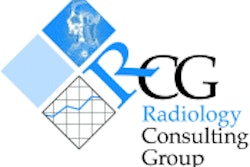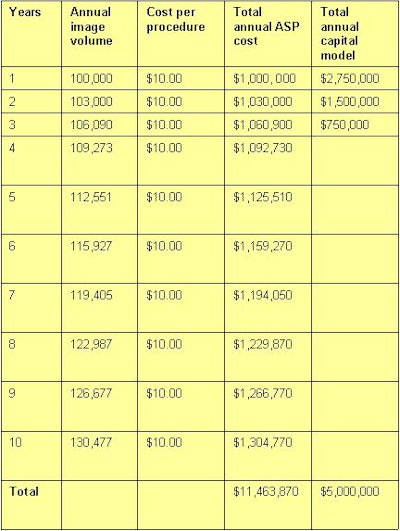
First Consulting Group

Although the ASP model is not a new concept, many different ASP flavors are available in the PACS marketplace. Understanding the differences between an ASP financing option versus a risk-sharing ASP is critical in choosing the model that is best suited to a facility's circumstances. In addition, there are benefits and drawbacks associated with various ASP models. All of these choices require rigorously developed cost comparisons to prudently evaluate the ASP decision.
Defining and distinguishing the ASP model
ASP models have been available in the market for several years, but the past two years have seen a significant marketing push from most of the PACS vendors. A PACS ASP model is distinguished primarily by the functionality provided by the vendor, the location and management of the equipment, and the financing options and levels of risk shared between the vendor and customer.
A PACS ASP offering provides imaging features and functionality that are identical to that of a capital-procured PACS. With several PACS vendors, the equipment configuration does not vary between ASP and capital models. Therefore, to the users of the system in your facility, this style of ASP model will be transparent.
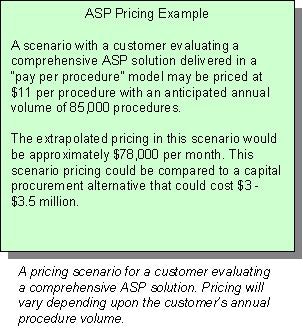 |
Vendors now offer a variety of ASP options, ranging from an ASP configuration that encompasses all of the PACS equipment components (such as data center equipment, workstations, and so on), to ASPs that provide storage, archiving, or image distribution only. An institution’s management will need to evaluate and determine the type of imaging services and scope of image deployment that will be needed to choose among the ASP options.
ASP services are often managed and delivered from the vendor’s offsite data center. In this example, the data center equipment (servers, archives, and so on) is owned and operated remotely by the vendor. A high-speed network connection between the vendor’s data center and the customer provides availability and accessibility to the images.
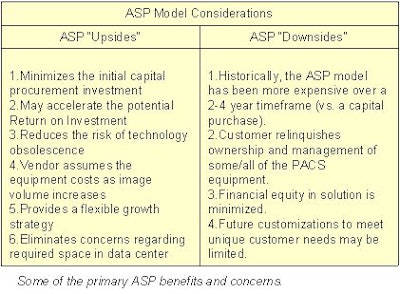 |
Financially, an ASP model provides a method for leasing a PACS solution as opposed to the large initial capital outlay that comes with procuring all the hardware and software components up front. Financing a PACS ASP is typically derived in a fee-for-use method by which the customer pays the vendor a monthly fee based upon an agreed benchmark (such as utilization of the system, number of procedures performed, amount of storage used for imaging, etc.).
There are also several inherent benefits associated with a vendor-managed remote data center ASP solution. Some of these benefits include:
- Technology obsolescence avoidance -- Major hardware and software components remain the property and responsibility of the ASP vendor. Depending on the terms of the agreement, customers may periodically execute a "technology refresh" to ensure that they receive the latest and most sophisticated hardware components and software releases. The vendor is also responsible for scaling the solution to meet the storage needs of its client.
- Business continuation/disaster recovery -- ASP archiving provides for business continuity in the event of a disaster. All images are stored offsite in a secure, well-monitored data center location. Customers are able to handle disasters according to their own plans and protocols while knowing their image data is safe and secure.
- Health Insurance Portability and Accountability Act regulation protection --Maintaining adherence to future HIPAA regulations is a continued concern for many customers. The ASP vendor is responsible and accountable for adhering to any HIPAA regulations, since they own and manage the solution.
Factors influencing the ASP decision
While it may appear that a PACS ASP model can provide the best of both worlds to a healthcare institution with advanced technology and service at reasonable price, there are several factors to consider when contracting for an ASP, as seen in the table, below.
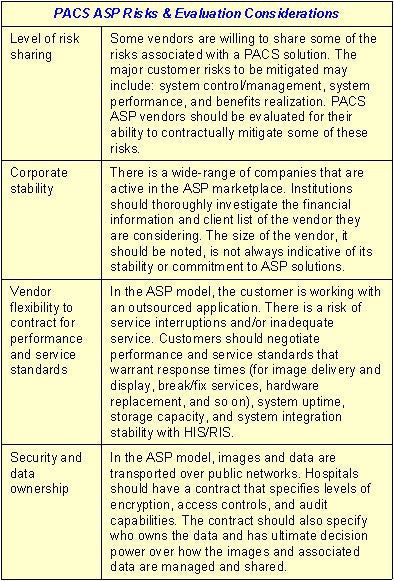 |
Risk sharing by the vendor is a major differentiating factor when evaluating an ASP solution. By linking customer ASP payments to the risk factors, many of the customer concerns will be mitigated and better managed.
For example, the vendor may warrant the system performance and a benchmark for the facility’s targeted film savings. If the vendor’s system does not meet the agreed-upon performance specifications, the customer is not required to pay. In addition, if the customer is not able to realize the entire targeted film savings over a specified timeframe, the vendor may deduct the amount from the payment schedule and work with the customer to realize the targeted benefits.
When customers enter into an ASP agreement, the ASP vendor expects to recoup its equipment costs, plus the additional cost of financing the customer’s term of the contract, plus a profit. The pricing calculation and the schedule are developed to favor the vendor’s interests. If realization of benefits is incorporated into the pricing agreement, it will be critical to establish measurable and manageable benefit metrics. Operational benchmarking should be performed to identify a measurable reference point. This data should then be incorporated into the vendor contract.
Making the ASP decision
Ultimately, the ASP decision should be based on business needs, financial data, and user input. As ASPs are not widely deployed across the market, it can be difficult to "touch and feel" a reference system in a nonvendor-sponsored environment. Wherever possible, institutions should visit sites that have successfully installed a PACS using the ASP model. It may also be valuable to visit the ASP vendor’s data center to obtain a better comfort factor with their operations and physical and data-level security.
The other major factor in deciding on an onsite or ASP model is affordability versus cost. While the initial capital outlay required for ASP model may be less than an onsite PACS, the total cost of ownership over time will be more.
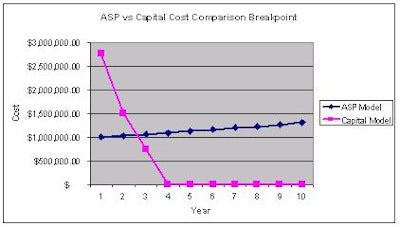 |
The graph above illustrates a sample practice scenario for the cost comparison between an ASP and capital-model PACS. The intersection of the two lines represents the point in time when an ASP approach to PACS becomes a more expensive solution than a capital-model approach. The scenario shows this cost intersection between years two and three. Please note that costs vary depending upon the vendor, implementation approach, and the volume of procedures performed.
In the scenario presented below, the sample practice performs 100,000 procedures per year. This practice is projecting a steady procedure growth over the next several years. A growth factor of 3% per year is applied to the annual volume figure.
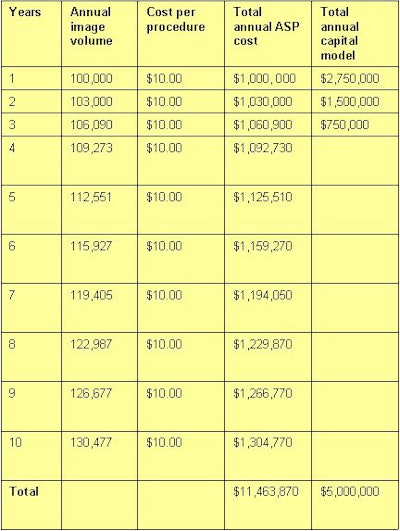 |
A sample ASP pricing of $10 per procedure was used to represent the cost per procedure that was quoted by a vendor for providing PACS and CR hardware, software, and management of the solution in an offsite data center. Total annual ASP costs are the result of multiplying cost per procedure by annual volume.
The capital costs represent total cost for PACS and CR over a three-year phased implementation. It should be noted that neither model includes any nonvendor project costs (for example, DICOM upgrades, system interfaces) or ongoing PACS reinvestment over the 10 years represented. As can be seen, the total cost of the ASP model is significantly greater over a 10-year period than a similar capital-model PACS.
Front-line observations
Our experience to date with pure ASP PACS environments indicates the following:
- Full ASP solutions have been more prevalent at sites with less than 50,000 procedures per year. This results from the reluctance and/or difficulty of smaller organizations in laying out the large capital sums required for a traditional PACS purchase.
- Most organizations are reluctant to participate in the lease-type arrangement inherent in the full ASP model. They do not want to relinquish control of the data and the equipment used to maintain their archives.
- Distribution models have been actively supported and implemented in a variety of environments. Distribution is used to support the entire enterprise -- as opposed to servicing radiology exclusively -- and more readily demonstrates the value of digital imaging. In addition, the organization maintains ownership and control of the primary PACS equipment while contracting a vendor to provide service levels.
- Implementing an ASP for enterprise distribution (for example, Web distribution throughout a hospital enterprise) is experiencing rapid growth in the market. This model is recommended and should be further evaluated for the following environments:
- Customers interested in piloting a Web-distribution imaging solution with minimal financial investment.
- Those who would prefer a "best of breed" vendor approach for the PACS distribution solution.
- Those who would like to expand and enhance the available features and functionality of their current PACS network.
- A comprehensive PACS ASP model for large organizations (> 50k procedures per year) has not widely demonstrated value to justify the long-term investment (versus a capital purchase). This type of ASP should be re-evaluated, as this model’s market matures and the pricing becomes more competitive and justifiable. A full PACS ASP model will continue to work well for a lower volume (< 50k procedures per year), single-site institutions.
- Vendor ASP risk-sharing agreements are highly recommended when evaluating an ASP solution. Linking the ASP pricing and contract to risk factors such as system performance, benefits realization, and system management, will maximize the success of a chosen solution, and any drawbacks will be better mitigated and managed.
We recommend carefully analyzing the costs of a full PACS ASP, an ASP-distribution solution, and an ASP archiving solution, and comparing the value of an ASP-model solution to the business and capital requirements of the institution.
By Peter Horton and Jay BackstromAuntMinnie.com contributing writers
January 22, 2002
First Consulting Group is a provider of consulting, integration, and information technology services to healthcare, pharmaceutical, and other life sciences organizations.
Related Reading
Reinvestment optimizes PACS productivity, November 21, 2001
The state of the enterprise digital imaging market, October 23, 2001
Copyright © 2002 First Consulting Group







